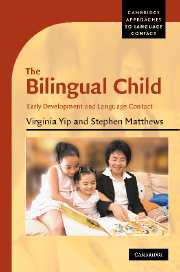Book contents
- Frontmatter
- Contents
- List of tables and figures
- Series editor's foreword
- Preface
- Acknowledgments
- List of abbreviations
- 1 Introduction
- 2 Theoretical framework
- 3 Methodology
- 4 Wh-interrogatives: to move or not to move?
- 5 Null objects: dual input and learnability
- 6 Relative clauses: transfer and universals
- 7 Vulnerable domains in Cantonese and the directionality of transfer
- 8 Bilingual development and contact-induced grammaticalization
- 9 Conclusions and implications
- References
- Index
- Author index
1 - Introduction
Published online by Cambridge University Press: 08 January 2010
- Frontmatter
- Contents
- List of tables and figures
- Series editor's foreword
- Preface
- Acknowledgments
- List of abbreviations
- 1 Introduction
- 2 Theoretical framework
- 3 Methodology
- 4 Wh-interrogatives: to move or not to move?
- 5 Null objects: dual input and learnability
- 6 Relative clauses: transfer and universals
- 7 Vulnerable domains in Cantonese and the directionality of transfer
- 8 Bilingual development and contact-induced grammaticalization
- 9 Conclusions and implications
- References
- Index
- Author index
Summary
Mother: Daddy hai6 me1 jan4 aa3? ‘What's Daddy's nationality?’
Child: Ing1gok3jan4 ‘English person.’
Mother: Jing1gok3jan4 ‘English person.’
Child: Ing1gok3jan4 ‘English person.’
Maa1mi4 hai6 zung1gok3jan4 ‘Mummy is Chinese.’
Mother: Timmy hai6 me1 jan4 aa3? ‘What about Timmy?’
Child: Bilingual!
(Timmy 2;00;14)Introduction
Talking to a young bilingual child can be both entertaining and eye-opening. Even at the tender age of two, the bilingual child is capable of expressing complex ideas, having two languages at his disposal as seen in the above exchange between Timmy and his mother (the first author). Timmy refers to his father as ing1gok3jan4 ‘English person’, his mother as zung1gok3jan4 ‘Chinese person’ and he surprises everyone, not least his mother, by referring to himself as bilingual. Apart from raising deep issues of awareness of identity, this exchange epitomises an important phenomenon typical of a bilingual child, namely that he is in contact with two languages on a daily basis.
What is it like being a bilingual child? How do children cope with learning two languages simultaneously in the first years of life? Many children, like those of cross-cultural marriages, grow up in families where more than one language is spoken on a regular basis. Their parents may each speak a different language natively, thus exposing these children to two languages from birth. The principal protagonists of this book are three siblings born in such a family where the mother is a native speaker of Cantonese (the first author) and the father of British English (the second author).
- Type
- Chapter
- Information
- The Bilingual ChildEarly Development and Language Contact, pp. 1 - 21Publisher: Cambridge University PressPrint publication year: 2007



